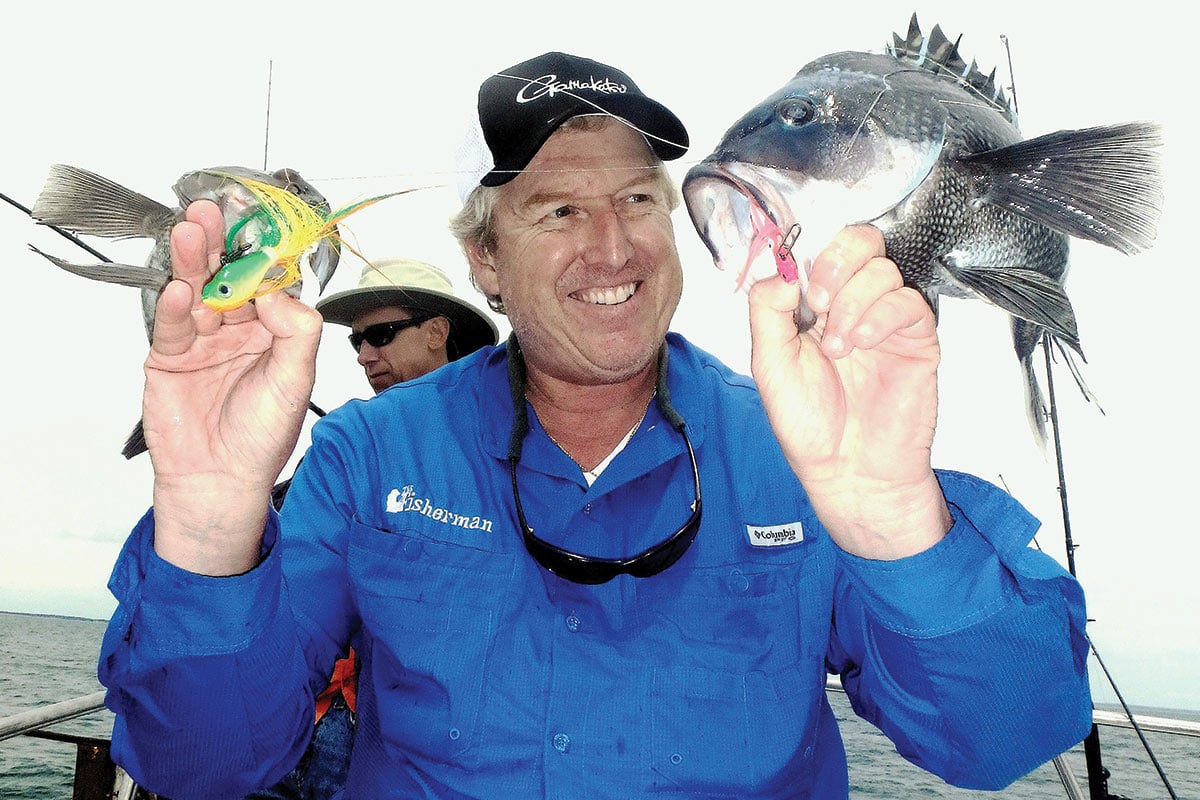
New Jersey & Delaware anglers are back in black sea bass this month!
As fishermen most of us are programmed to want that new “light tackle” way to catch whatever species we may be after. Jigging for black sea bass is no exception!
Black sea bass are prized table fare for anglers in the Northeast. We find ourselves chasing sea bass from local reefs, rubble, and rock piles in the warmer months out to the 60-plus mile offshore wrecks in the winter. Regardless of the time of year and setting, jigging sea bass is a technique that allows us to have a ton of fun using artificials on lighter tackle while putting bigger fish in the cooler!
Jigging for sea bass is a technique that is most successful when the conditions are ideal. Days that offer light and variable winds with moderate to little tide will certainly help yield the best results. Proper jig presentation is the key for putting a catch together so if the conditions are not right, put the jig rod away until your next trip!
Occasionally weather forecasts may look perfect to jig but a screaming tide will have you fishing 5- and 6-ounce jigs instead of the 2- and 3-ounce jigs. Unfortunately there are going to be some days when conditions make jigging nearly impossible. On the right day jig fishing is pretty versatile as anchoring and drifting are both effective.
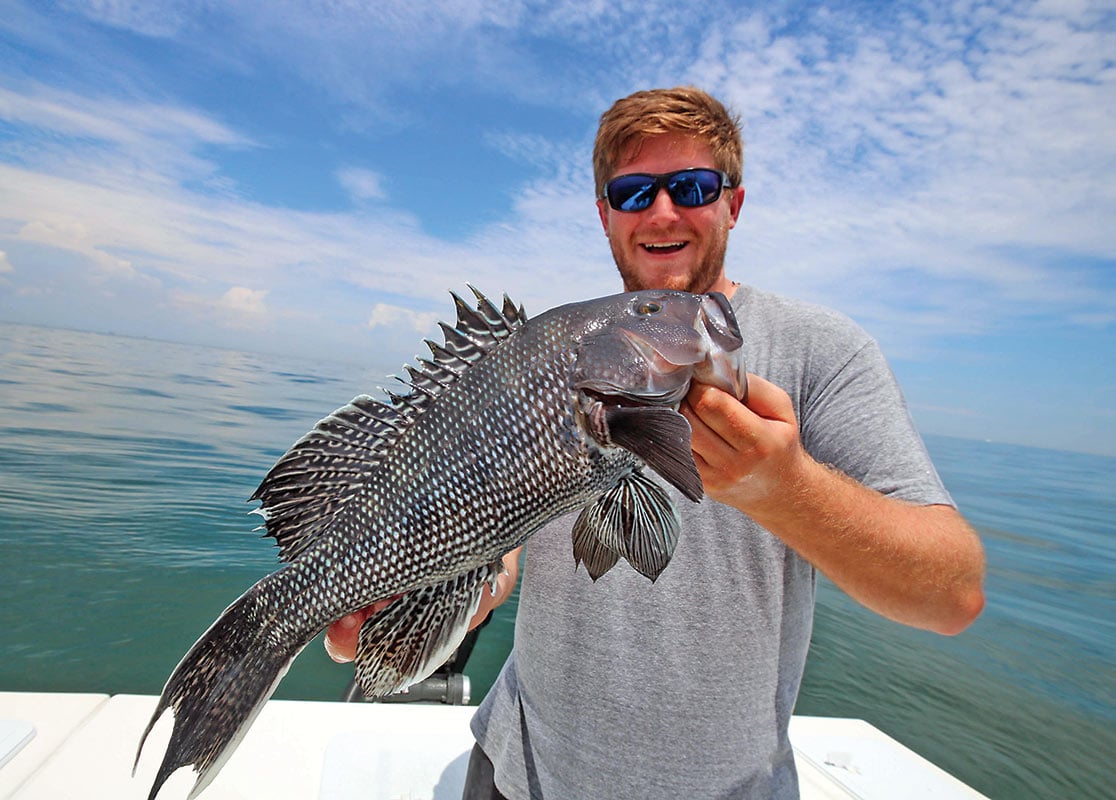
Geared Up
Conveniently enough you most likely already own a suitable rod and reel. Most medium action rods are proficient for jigging. I’d say it’s almost a 50/50 split for spinning vs. conventional jig swinging anglers. It boils down to what you are most comfortable with. You want a rod in the 6- or 7-foot range that is light enough to properly work your jigs but heavy enough to drive hooks home in the mouth of a sea bass. Not enough backbone and you’ll find yourself struggling while hooking fish.
On trips where I know conditions will allow me to jig I bring my 6-1/2-foot medium-heavy Tsunami Slow Pitch conventional rod, accompanied by a Daiwa Lexa 300 spooled with 20-pound Daiwa J-4 J-Braid. I prefer the J-4 verses the J-8 for abrasion resistance purposes. My spinning outfit that sees the most action is a Major Craft Solpera light jigging rod with a Daiwa Tatula 400 CHX also spooled with 20-pound Daiwa J-4 braid. Most 3000- or 4000-size spinning reels are fine to use since you don’t need too much drag, torque or line capacity.
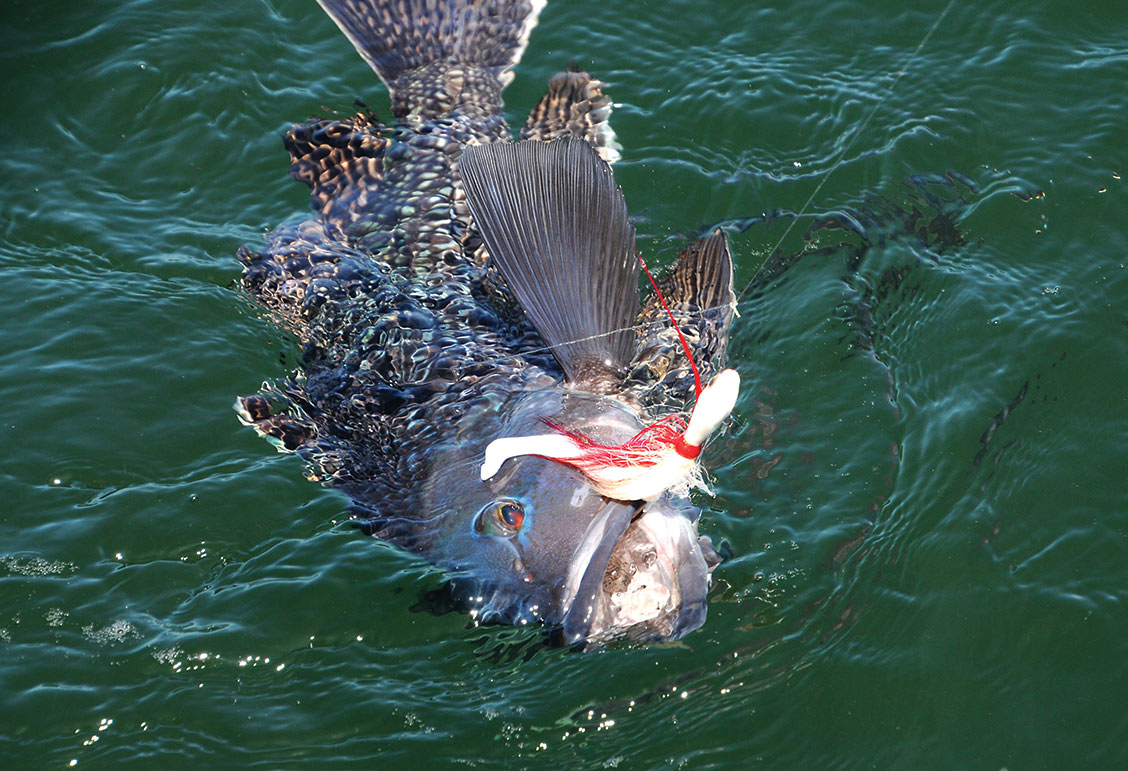
Braid is the way to go for anglers looking to jig. Keep in mind 20-pound braid is less than half the diameter of 20-pound mono; that thin diameter braid will have less drag in the water, which helps get to the bottom faster properly presenting the jig. The disadvantages of using heavy braided line or monofilament is scope and bowing in the line. Both will cause you to miss bites or put your jig out of the “strike zone.”
With those factors in mind using thin braid will also allow you to use lighter weight jigs. Less line scope equates to being able to fish almost straight up and down. Most big name brands of braid are very similar in diameter but I’ve found the J-Braid is just a hair thinner.
As I get my setups ready to fish I tie in a 10-foot length of 20- or 30-pound leader. This leader allows some stretch in the line. Since braid has no stretch anglers who do not use a leader and tie direct to the braided line find themselves pulling hooks and losing fish. Having that 10-foot shot of monofilament also acts as protection on those sharp wrecks or sticky bottom. At the end of the monofilament leader I tie in a 75-pound Tactical Anglers clip so I can easily change jigs.
The Business End
Fishing a teaser while jigging is a great tool for filling the box. A teaser pinched onto a dropper loop about 12 inches above your jig could find you catching doubleheader knuckleheads! Similar to fishing a teaser for striped bass its effectiveness is hard to beat. I’ve seen a bunch of different artificials used as teasers with the most successful being a 3- or 4-inch Fin-S fish. Other alternatives are surf candy flies, red gill sand eels and 4-inch Berkley Gulp swimming mullet. Usually these baits are threaded through a 3/0 hook.
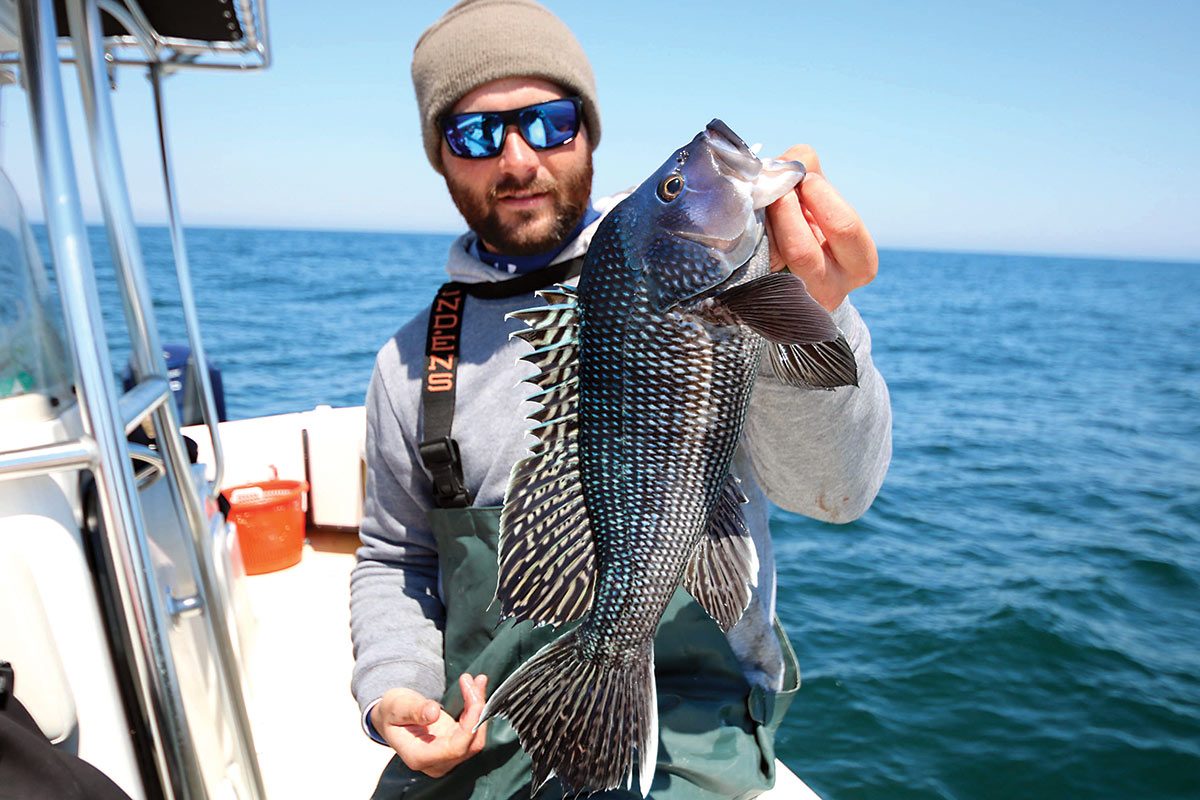
My jig bag is pretty heavy and cluttered from the different style and size jigs I’ve acquired over the years. Most of them are slim profile sand eel imitators ranging from 60 to 120 grams. Sand eels are found in numbers almost every time of year where these sea bass live. Some easily accessible staple sea bass jigs consist of the Shimano Colt Snipers, Hogy heavy Sand Eel, or just a regular old diamond jig. When it comes to picking jigs don’t get too fancy as you will end up donating them to the snaggy bottom over time anyway!
“Slow pitch jigging” which originated in Japan has become an increasingly popular style of jigging here in the United States. This technique when mastered is a deadly addition to any fisherman’s arsenal. Slow pitching is such a successful technique thanks to the jig design, which allows a slower fall and wobble putting you in the “strike zone” longer. Most slow pitch jigs tend to have a wider surface and intriguing cuts on the backside of the jig offering an irresistible slow falling motion. I find myself hooking some of my largest sea biscuits on the drop.
Unfortunately there are only a few shops in the tri state area that offer true, imported, hand painted slow pitch jigs, but with this style becoming popular there are now plenty of options easily accessible to local anglers. Having a slow pitch style rod designed for the specific jig weights you plan on fishing will certainly give you a leg up on other fishermen.
Once you’re all rigged up it’s time to put it all together. Unlike jigging for blackfish where you want to keep the jig still, moving the jig is the key to getting bites and putting sea bass in the cooler. Fishing jigs allows you to cover a big part of the water column. Suspended fish on top of a wreck or 5 to 10 feet off the bottom regularly fall victim to the jig. The simplicity aspect paired with its effectiveness makes jigging for sea bass a can’t-miss technique.
After the jig makes contact with the bottom most style jigs are worked best by pointing the rod tip at the water followed by a lazy sweep of the rod to the 10 o’clock position. Typically I bounce the jig off the bottom four or five times trying to imitate a nervous sand eel. If I can’t fool one on the bottom I start making my way up the water column. One turn of the handle is followed by another tip to 10 o’clock sweep of the rod. Oftentimes the bite will come just as I bow my rod back to the water after a sweep.
Once you get dialed in and have a good understanding of where fish are holding that particular day it can be all out drop and reel fishing. Anglers have been using jigs to effectively fool fish for decades. From pelagics to bass and bluefish jigs are tools that are not being phased out anytime soon.
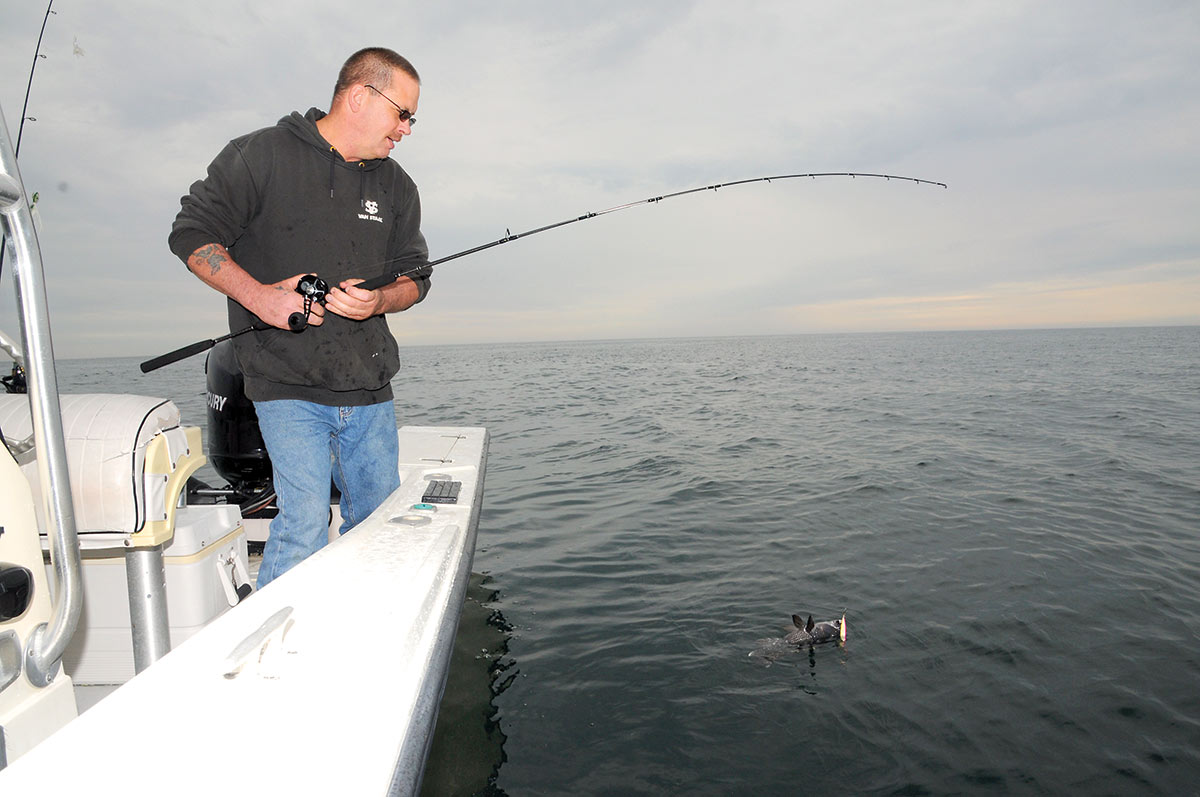
| SEA BASS REGS |
|---|
| Delaware: 12-1/2 inches, open 5/15-12/31 (15 fish)
New Jersey: 12-1/2 inches, open 5/15-6/22 (10 fish); 12-1/2 inches open 7/1-8/31 (2 fish); 12 1/2 inches open 10/8-10/31 (10 fish); 13 inches open 11/1-12/31 (15 fish) New York: 15 inches, open 6/23-8/31 (3 fish), 9/1-12/31 (7 fish) |



